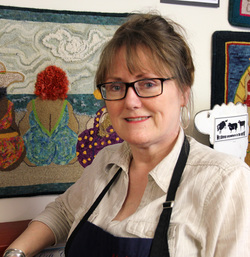After many years of admiring and lusting after the beautiful hooked rugs produced by our Maritime artisans, I finally took a beginner course in 1995. Instantly hooked, it has been a wonderful obsession for over the past ten years. I joined the Rug Hooking Guild of Nova Scotia that same year and have attended their Rug School six times. I work almost exclusively in recycled wool, most of it purchased at “Frenchy’s”, our famous Maritime used clothing outlets. This is one of the aspects of rug hooking I enjoy the most: turning cast offs into functional and decorative “works of art”!
In 2003 at the annual Rug School put on by the Rug Hooking Guild of Nova Scotia, teacher Doris Norman gave a presentation on the William Morris Class she would be teaching at the next Rug School in 2004. When the application forms came out I signed up and was lucky enough to get my first choice. I briefly considered designing my own pattern, but my friend Christine Little, who owns Encompassing Designs Rug Hooking Studio in Mahone Bay, Nova Scotia, was in the process of designing several William Morris rug patterns. She convinced me to hook the “Forest Tapestry Lion” and she also supplied me with the Majic Carpet Dye formula for the lion: “Max Brown” from her then unpublished dye book, “SkyBluePink With A Green Smell”.
Several years ago I attended a class at Rug School on hooking scrolls and another one on fine leaf shading at Spruce Top Rug Hooking Studio, so I was familiar with the concept of “turnovers” on leaves… and painfully aware of how many there were on this pattern! I had learned that the easiest way to achieve the definition required for a good turnover is to use two different swatches. In this case I used Majic Carpet Dyes, 6 values each of the “Sage Green” and “Spruce Green” from Susan Logue’s Past & Present Antique Colours & Spots”dye book. I dyed each formula over two pieces of white, two chartreuse, one light beige and a light beige tweed. The resulting six values of each colour gave me more than enough wool to work with, a good separation of values and just the right definition for the turnovers.
The navy background came from several different medium and dark navy skirts married together and set in the dye pot. The flowers and the lion’s mane were all hooked with wool left over from
various projects and the border was hooked in one of the “Max Brown” values left over from the lion.
During class I referred to all the visual aids our teacher, Doris Norman, had on display. With her help and encouragement I started hooking the acanthus leaves although I spent the bulk of class time working on the lion’s face. Never having taken a “fine cut animals” class, it was serendipity to have just such a course being taught down the hall, and I visited it to look at their visual aids and to pick the teacher’s brain a little.
Over the next two months I finished the rug at home and I was very pleased with the way the lion’s face turned out. After gaining confidence hooking the many leaves, I decided to “un-hook” the first few I did and give them another try. The finished rug hangs in a place of honour in my den where I hook every day.
By Guest Blogger Susan Leslie









 RSS Feed
RSS Feed






